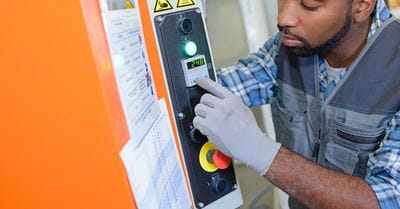Vertical Reciprocating Conveyors | Orange County

Raymond West supplies warehouse automation equipment such as VRC's.
We are among the largest suppliers of warehouse automation equipment in the state.
Call us today at (714) 790-9300.
What Is a Vertical Reciprocating Conveyor (VRC)?
A VRC is an efficient, relatively inexpensive, simple way to transport goods from one level to another. VRCs have use case scenarios in a host of different industries, including factories, storage facilities, distribution centers, and other multi-level operations. These adaptable pieces of equipment can easily be integrated with a structure’s mezzanine, balcony, basement or any higher story levels.
VRC’s consist of a shaft, a cage, and a mechanical or hydraulic system. Vertical material lifts can be added almost anywhere inside or outside of a building. Barriers and enclosures surrounding a VRC shaft keep workers safe and prevent accidents.
What Are Some Advantages of VRCs?
Safety: Many operations are dependent upon forklifts to move their materials and merchandise from one level to another. Although highly capable machines, forklifts are primarily designed for the horizontal movement of goods. In the name of efficiency, employees may occasionally take their lift trucks above their height limit or move goods beyond their truck’s capacity rating. When these transgressions occur, the likelihood of an accident multiply.
For some vertical transport of goods between levels, VRCs provide a safe and effective alternative to forklifts. Specifically designed and fabricated for each operation’s application demands, VRCs substantially diminish the chances of human error.
In addition, vertical material lifts are engineered to move larger loads on a more frequent basis. These more rapid throughput rates result in less labor hours and lower costs. For companies that have routine vertical transport demands, VRCs can enhance worker safety and decrease labor expenses.
Customization: One significant advantage of vertical reciprocating conveyors is the degree to which they can be customized. Since passenger elevators are designed to safely move humans, there are numerous regulations that limit the weight capacity, speed and size of these machines. While such safeguards are necessary and advisable for safely transporting people, they are inhibitive for high throughput movement of goods in production facilities, storage facilities and distribution centers. Vertical lifts can be readily customized due to the fact that they are not bound by the same laws as passenger elevators.
Regulation: VRCs are engineered to move materials only, while standard elevators are built to move both humans and materials. Due to this important difference, VRCs are exempt from the stringent elevator standards in most states.
On the contrary, VRCs are regulated by their own national code that is under the authority of the American Society of Mechanical Engineers (ASME), one of the preeminent standards establishing organizations in the country. More specifically, vertical reciprocating conveyors must comply with ASME’s Safety Standard for Conveyor and Related Equipment (ASME B20.1-2018). This standard outlines the rules for the fabrication, installation, operating procedure and servicing of conveyor systems.
Raymond West Is A Full Service Supplier of Vertical Reciprocating Conveyors
If you’re in the market for a VRC, have questions or require engineering support, Raymond West can give you a hand. Our material handling professionals can help design, procure, install and service a system that’s right for your operation. Get in touch with us today!
Raymond West's Orange County service area includes Anaheim, Costa Mesa, Fullerton, Garden Grove, Orange, Santa Ana, Tustin and all surrounding areas.
Raymond West | Orange County Material Handling Equipment Supplier
Orange County, CA
(714) 790-9300

